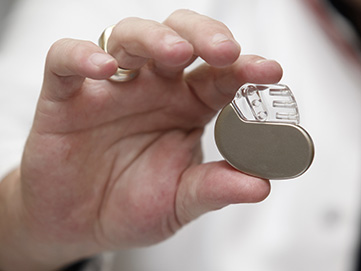General Overview
 Our pacemaker/ICD clinic provides patients with specialized care of implanted rhythm management devices and pacemakers. The physician team educates patients about the devices and answers ongoing questions related to living with an implanted rhythm management device. Patients must know how their pacemaker and ICD works to understand why it regulates the heart rate.
Our pacemaker/ICD clinic provides patients with specialized care of implanted rhythm management devices and pacemakers. The physician team educates patients about the devices and answers ongoing questions related to living with an implanted rhythm management device. Patients must know how their pacemaker and ICD works to understand why it regulates the heart rate.
People often ask, “What is a pacemaker?” The term has been around for years, but today’s pacemaker is nothing like your grandfather’s device. The pacemaker is the generic term for a small unit about the size of a pocket watch. The pacemaker reliably monitors and controls the user’s heart rate. A minor surgical procedure is used to place the device under the skin and near the heart. The pacemaker procedure helps patients to normalize a slow heartbeat.
The patient’s heart may have a faulty regulator and a pacemaker of the heart corrects this problem. If the patient’s heart does not beat regularly or fast enough, fatigue, difficult breathing, or fainting can result. If the heart’s ability to regulate beat pacing is not working well, the pacemaker implant uses electrical impulses to cause the heart to beat more quickly.
A bi-ventricular pacemaker regulates the heart’s pace and improves pumping efficiency in those patients with CHF valve damage. The bi-ventricular type of pacemaker ensures that the patient’s atria and ventricles work properly. Cardiac re-synchronization therapy uses this type of pacemaker.
Defibrillator or ICD is similar to a pacemaker but it acts as a safety net for patients who have or at high risk of fast heart rhythm which can be deadly.
Most of our patients are in the remote monitoring system, where the Pacemaker/ICD are evaluated remotely on a regular basis and evaluated for any alerts or any abnormalities. They are checked in the office frequently on a regular basis or checked whenever felt essential.
Types of Services Offered
The Pacemaker/ICD Clinic goals include:- Patient care
- Follow-up associated with device performance
- Patient/family education
The pacemaker/ICD clinic team works with the patient’s primary health care provider and cardiologist to help him or her enjoy the benefits of a healthy heart.
